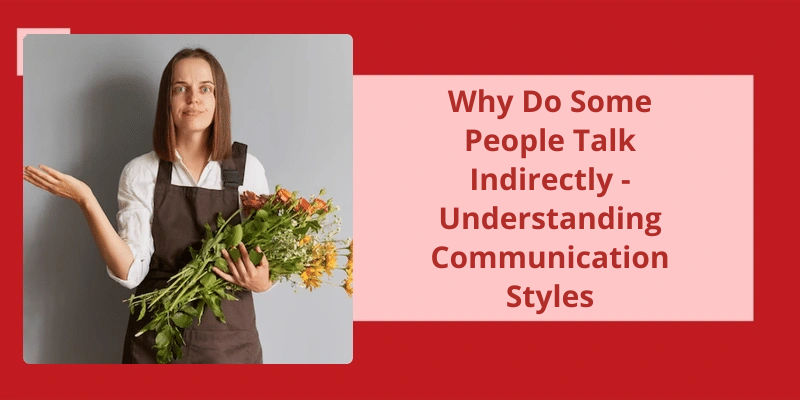Human communication is a complex and multifaceted phenomenon, where individuals often resort to various ways of conveying their thoughts and emotions. Some people prefer to speak indirectly, rather than directly, leaving their interlocutors to decipher their intended meaning. This practice is common in different cultures and settings, and people have different reasons for choosing to communicate indirectly. While some use indirect communication to save face or prevent confrontations, others may fear offending or hurting others with their words. The phenomenon of indirect communication raises questions about it’s effectiveness, perceived meanings, and the role of culture and context. Understanding the reasons for indirect communication can help us develop better communication skills and build stronger relationships with others.
What Causes People to Be Indirect?
Another reason why people communicate indirectly is to try and convey their message without actually owning up to it. This is often done in a manipulative way and can be seen as a dishonest approach. It can also be done to avoid responsibility for the outcome of the situation. In some cases, people may feel ashamed or embarrassed about their thoughts or feelings and thus don’t want to address it directly with others.
Indirect communication can also be a result of cultural or societal norms. In some cultures, it’s considered impolite or disrespectful to express oneself directly. This can lead to confusion and misunderstandings when interacting with people from different cultural backgrounds. Additionally, in certain societies, hierarchical structures may make it difficult for individuals to express their opinions openly and directly to those in positions of authority.
Insecurity can also lead to indirect communication. If someone lacks confidence in their ability to communicate effectively or fears judgment from others, they may resort to indirect communication as a way of protecting themselves. This can manifest in different ways such as sarcasm, passive-aggressive behavior or beating around the bush.
Lastly, language barriers can also be a contributing factor to indirect communication. When communicating in a second language, individuals may not have the same level of fluency or comfort as in their native language. As a result, they may struggle to express themselves clearly and thus use indirect methods to get their point across.
These can include avoiding conflict, trying to convey a message without responsibility, cultural or societal norms, insecurity and language barriers. It’s important to understand these reasons and to try and communicate as clearly and directly as possible in order to avoid misunderstandings and ensure effective communication.
Ways to Effectively Communicate With Someone Who Uses Indirect Communication
- Pay attention to nonverbal cues such as tone of voice, body language, and facial expressions
- Ask clarifying questions to ensure you understand the intended message
- Paraphrase what the person has said to confirm your understanding
- Be patient and allow the person time to express themselves
- Avoid interrupting or appearing confrontational
- Use active listening techniques such as restating important points and reflecting on emotions
- Try to empathize with the person’s perspective and point of view
- Provide feedback or your own perspective in a non-threatening and respectful manner
- Ask how you can best communicate with the person in the future
In addition to the benefits mentioned above, indirect communication can also foster stronger relationships and build trust. It allows for deeper understanding and empathy, as individuals take the time to truly listen and consider their words before speaking. However, like all forms of communication, there are also potential drawbacks to consider.
Is Indirect Communication Good?
Moreover, indirect communication can also promote creativity and problem-solving. By not explicitly stating your intentions or messages, you’re stimulating the other persons mind to engage in critical thinking to interpret your signals. This can lead to a discussion where both parties become creative in finding solutions and innovative ideas. In a professional setup, indirect communication can spark brainstorming sessions and lead to better projects or products.
Furthermore, indirect communication can be beneficial in delicate or contentious situations. For example, if a manager wants to criticize an employees performance, they might choose to use a more indirect approach, rather than confrontational language. This can be more productive for both parties, as it puts less pressure on the criticized employee and offers them an opportunity to improve without feeling like they’re being attacked.
Indirect communication can also foster trust and build relationships. By using subtextual cues, such as humor, sarcasm, or metaphors, people can communicate more effectively with one another and feel more comfortable expressing themselves. This is especially important in social situations where people may not feel comfortable being upfront.
However, indirect communication can also have it’s drawbacks. Because the message isn’t explicit, it can be misinterpreted or ignored altogether. This can result in confusion, misunderstandings, and a lack of productivity. Moreover, indirect communication may not be effective for those who’ve a more direct communication style, leading to potential conflict.
It can promote creativity, prevent missteps, and build relationships. However, it should be used in moderation and with an understanding of it’s limitations. By balancing direct and indirect communication, individuals and organizations can create a healthy, productive environment.
Source: What Is Indirect Communication? – CultureWizard
While some may argue that indirect communication is simply a matter of preference or cultural norms, there are those who question whether it can cross the line into manipulation. It’s worth exploring whether our tendency to hint or imply rather than explicitly state our thoughts and feelings can sometimes be a way of trying to control the reactions of those around us.
Is Indirect Communication Manipulation?
At it’s core, indirect communication is a strategy to influence people without being explicit in what we want. It can be done in various ways such as hinting, suggestive comments, body language, or subtle cues. The goal is to create the desired response without being too upfront. However, there’s a fine line between indirect communication and manipulation, and it’s not always easy to distinguish the two.
When we use subtle cues to try and influence someones behavior or emotions, were essentially trying to control them. This can be unethical, especially if were doing it to get our way or to gain an advantage over them. Manipulative behavior can erode trust and damage relationships in the long run.
However, not all indirect communication is manipulative. Sometimes, we may use it to be tactful or respectful of others feelings. For example, if someone asks us to do something, and we don’t want to, we may use indirect language to soften the blow. In this case, weren’t trying to manipulate the person, but rather to avoid hurting their feelings unnecessarily.
If were using it to try and control someone, then it can be unethical and damaging to relationships. But if were using it to be tactful or respectful, then it can be a useful tool for navigating social situations. It’s important to be aware of our own communication style and to be mindful of how it affects others. By being clear and direct when necessary and using indirect communication strategically, we can create healthier, more positive relationships.
How to Recognize and Respond to Manipulative Behavior in Indirect Communication
To recognize and respond to manipulative behavior in indirect communication, it’s important to pay attention to nonverbal cues and contextual clues in the conversation. Look for inconsistencies in the person’s behavior and words, and be aware of any attempts to guilt or shame you into doing something. Respond by setting boundaries and calmly asserting your own needs and wants in the conversation.
Effective communication is key to building healthy and productive relationships, both personally and professionally. However, it can be difficult to navigate conversations with people who tend to speak indirectly. In such situations, it’s important to stay patient and focused, and to employ some proven techniques to help bring more clarity to the conversation. By being mindful and empathetic, you can create a safe space for effective dialogue, even when the communication style of the other person presents a challenge.
How Do You Deal With People Who Talk Indirectly?
It’s important to remember that indirect communication can often be a cultural or personality trait, and not necessarily a deliberate attempt to obfuscate or mislead. Be patient and understanding, and try to find common ground to build a productive conversation on.
Identify any triggers or sensitive topics that the other person might be avoiding, and try to steer the conversation away from these areas if they seem uncomfortable or defensive. Use active listening techniques to show that youre engaged and invested in the conversation, and reflect back the key points or concerns that the other person is expressing.
If youre still struggling to make headway with an indirect communicator, consider seeking outside help from a mediator or conflict resolution specialist. They can provide a neutral third-party perspective and help facilitate a more constructive conversation between all parties involved.
Remember that at the end of the day, effective communication is a two-way street. Be willing to adapt your own approach and style to better fit the needs and preferences of the person youre talking to, and be open to constructive feedback and criticism.
In summary, dealing with an indirect communicator can be a challenge, but with patience, understanding, and active listening, it’s possible to build a productive conversation and achieve mutually beneficial outcomes. Dont give up on the conversation and keep working towards a solution that works for all parties involved.
Common Cultural and Personality Traits Associated With Indirect Communication
- Politeness
- Indirectness
- High-context communication
- Non-verbal cues
- Avoidance of confrontation
- Respect for hierarchy
- Patience
- Implicitness
- Subtlety
- Discretion
Effective communication is key in any relationship, whether it be personal or professional. However, sometimes individuals may struggle with expressing their thoughts and feelings directly to others, leading to indirect communication. This can take many forms, such as passive-aggressive behavior, nonverbal cues, or hinting at a problem. In the workplace, indirect conversation can lead to misunderstandings and potentially harm productivity. Let’s explore this topic further and discuss how to navigate indirect communication in the workplace.
What Is an Example of Indirect Conversation?
Indirect conversation refers to communication that isn’t direct and explicit. In other words, it’s when people use subtle or vague language or behavior to express their thoughts and feelings. This type of conversation is often used when people are uncomfortable with confrontation or when they want to avoid hurting someones feelings.
Instead of saying it directly, they may use phrases like “Im not saying youre wrong, but…” or “It’s just my opinion, but…”. This way, they’re expressing their opinion without being too confrontational or aggressive.
They might say something like “I was wondering if it’s possible to…” instead of “Can you please…”. This way, they’re making a request without sounding too aggressive or bossy.
For example, if someone is telling a boring story, the listener might say “thats interesting” instead of “Im bored”. This way, they’re being polite without hurting the speakers feelings.
Instead of being blunt and saying “You did a terrible job”, they might say something like “Theres room for improvement” or “We need to work on this together”. This way, they’re giving feedback without being too harsh or negative.
However, it can also be frustrating or confusing for some people, especially if they aren’t used to interpreting subtle cues or reading between the lines. Nonetheless, it remains an important part of human communication, and it’s use has persisted throughout history.
Examples of Cultures or Societies Where Indirect Conversation Is More Common or Preferred.
- Japan
- China
- Korea
- India
- Iran
- Arab countries
- Mexico
- Colombia
- Venezuela
Conclusion
This behavior may stem from past experiences of feeling misunderstood or not heard, leading individuals to avoid direct communication out of fear of being rejected or invalidated. Indirect communication can also be influenced by cultural or societal norms that prioritize politeness, harmony, and avoiding direct confrontation. However, while choosing indirect communication styles may provide temporary relief, it may ultimately hinder healthy relationships and hinder personal growth. Effective communication requires open and honest dialogue, where individuals can express their thoughts, feelings, and needs in a direct and respectful manner.






